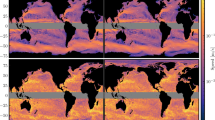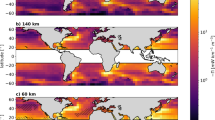Summary
Fluctuations in heat energy transfer between ocean and atmosphere were studied by means of spectral analysis of time series. The hydrometeorological parameters which contribute to the interface heat transfer were analyzed similarly. Data consisted of three years of 3-hourly surface observations at North Atlantic stations Charlie and Delta. Frequency domain results were emphasized, but time domain statistics were also examined.
Time series of different length and timestep were analyzed. Time sequence of 4-month or 2-month autospectra gave the spectral field of a variable during the three years. Spectral fields of energy transfer were compared to spectral fields of the contributing variables.
Spectral properties of heat transfer in the time range studied (6 hours to 20 days) are mainly governed by fluctuations of corresponding vertical gradient. However, some secondary maxima in the transfer spectral fields are chiefly induced by wind fluctuations. The bulk of the heat transfer occurs in intermittent pulsations.
Zusammenfassung
Schwankungen im Wärmetransport zwischen Ozean und Atmosphäre wurden mittels Spektralanalyse des zeitlichen Verlaufes dieses Transportes studiert. Die hydrometeorologischen Parameter, welche zum Wärmetransport durch die Meeresoberfläche bei-tragen, wurden auf ähnliche Weise behandelt. Die Daten bestanden aus 3 Jahren von dreistündigen Beobachtungen an den nordatlantischen Schiffstationen Charlie und Delta.
Resultate im Frequenzbereich wurden hervorgehoben, doch wurden auch die statistischen Ergebnisse im Zeitbereich untersucht.
Zeitfolgen von verschiedener Länge wurden unter Verwendung verschiedener Zeitintervalle analysiert. Zeitfolgen von viermonatigen und zweimonatigen Autokorrelationsspektren ergaben die spektrale Verteilung einer Variablen während der untersuchten drei Jahre. Die spektrale Verteilung des Energietransportes wurde mit den spektralen Verteilungen der dazu beitragenden Variablen verglichen.
Die spektralen Eigenschaften des Wärme transports in dem untersuchten Bereich (6 Stunden bis 20 Tage) werden hauptsächlich von Schwankungen der zuständigen vertikalen Gradienten beeinflußt. Einige sekundäre Maxima in der spektralen Verteilung des Wärmetransportes werden jedoch hauptsächlich von Windschwankungen hervorgerufen. Der Hauptanteil des Wärmetransportes tritt in Pulsationen mittlerer Zeitdauer auf.
Résumé
Des variations dans l'échange d'énergie thermique océan-atmosphère furent étudiées par analyse spectrale de séries temporelles. Les paramètres hydrométéorologiques contribuants aux échanges thermiques à la surface de séparation furent analysés pareillement. L'information consiste d'observations en surface prises à toutes les trois heures sur une période de trois ans, aux stations Charlie et Delta en Atlantique du Nord. L'emphase fut sur l'étude des fréquences bien que les statistiques temporelles furent aussi examinées.
Des séries temporelles variant en durée furent analysées avec diverses longueurs d'étapes. Des séquences d'autospectre de 4- ou 2-mois représentèrent le champ spectral d'un paramètre durant les 3 années. Les champs spectrals des paramètres contribuants furent comparés aux champs spectrals du transfert d'énergie.
Les charactéristiques spectrales de transmission thermique dans les étapes étudiés (6 heures à 20 jours) sont gouvernées principalement par les variations dans les gradients verticaux des paramètres associés. Par contre, certains maxima secondaires dans le champ spectral du transfert d'énergie sont principalement induits par les variations du vent.
La majeure partie du transfert d'énergie se fit par pulsations intermittentes.
Similar content being viewed by others
References
Bendat, J. S., and A. G. Piersol: Random Data. Analysis and Measurements Procedures. New York: John Wiley and Sons, 1971.
Byshev, V. I.: Time Variations of Some Atmospheric Characteristics near the Sea Surface. Oceanology,7, 744–755 (1967).
Byshev, V. I., and Yu. A. Ivanov: Time Spectra of Some Characteristics of the Atmosphere above the Ocean. Izvest. Acad. Sciences, USSR, Atmospheric and Oceanic Physics,5, 8–13 (1969).
Chisholm, W. J.: Factors Contributing to Evaporation over the North Atlantic. M. Sc. thesis (unpublished). Dept. of Meteorology, McGill University, Montreal (1966).
Holloway, Jr., J. L.: Smoothing and Filtering of Time Series and Space Fields. In: Advances in Geophysics,4, 351–389. New York: Academic Press Inc., 1958.
Jakobsson, T. E.: Spectral Analysis of Marine Atmosphere Time Series. Ph. D. thesis (unpublished). Dept. of Meteorology, McGill University, Montreal (1973).
Jenkins, G. M., and D. G. Watts: Spectral Analysis and its Applications. San Francisco: Holden Day, 1968.
Kolesnikova, V. N., and A. S. Monin: Spectra of Meteorological Field Fluctuations. Izvest. Acad. Sciences, USSR, Atmospheric and Oceanic Physics,1, 377–386 (1965).
Kraus, E. B., and R. E. Morrison: Local Interactions between the Sea and the Air at Monthly and Annual Time Scales. Quart. J. Roy. Meteorol. Soc.,92, 114–127 (1966).
Maruyama, T.: Time Sequence of Power Spectra of Disturbances in the Equatorial Lower Stratosphere in Relation to the Quasi-Biennial Oscillation. J. Meteorol. Soc. Japan,46, 327–341 (1968).
Palmen, E., and C. W. Newton: Atmospheric Circulation Systems. International Geophysics Series,13. New York, and London: Academic Press Inc., 1969.
Robinson, G. D.: Another Look at Some Problems of the Air-Sea Interface. Quart. J. Roy. Meteorol. Soc.,92, 451–465 (1966).
Roll, H. U.: Physics of the Marine Atmosphere. New York and London: Academic Press Inc., 1965.
Walsh, J. E.: Handbook of Nonparametric Statistics. Princeton, New Jersey: D. Van Nostrand Company Inc., 1962.
Author information
Authors and Affiliations
Additional information
With 8 Figures
Rights and permissions
About this article
Cite this article
Jakobsson, T. Time sequence of energy exchange spectra at ocean stations Charlie and Delta. Arch. Met. Geoph. Biokl. A. 25, 187–206 (1976). https://doi.org/10.1007/BF02246368
Received:
Issue Date:
DOI: https://doi.org/10.1007/BF02246368




